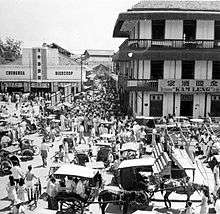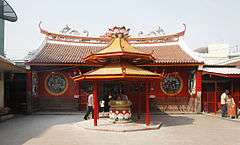Glodok

Glodok (Chinese: 裹踱刻) is an administrative village of Taman Sari, West Jakarta, Indonesia. The area is also known as Pecinan or Chinatown since the Dutch colonial era, and is considered the biggest in Indonesia, as a majority of the traders in Glodok are of Chinese descent.
Nowadays the area is known as one of the biggest center for electronics in Jakarta, Indonesia.
Toponomy
The word Glodok came from the Sundanese word "Golodog", meaning entrance to a house, as Sunda Kalapa (Jakarta) is the gateway to the ancient Sundanese Kingdom. It was also thought that the name came from the "grojok grojok" sound that water makes coming out of a waterspout in the yard of the Cityhall (Stadhuis), now the Jakarta Museum. A waterspout was built on this site in 1743 and was used for daily needs such as a watering hole for horses.[1]
History

Early
In Batavia (now Jakarta), Dutch colonialism created commercial opportunities which attracted immigrants from many areas of what is now Indonesia. This economic activity also lured thousands of Chinese people to Java. Swift immigration challenged the city's limited infrastructure and created burdens on the city. Tensions grew as the colonial government tried to restrict Chinese migration through deportations.
Glodok and Jakarta Riots
On 9 October 1740, 5,000 Chinese were massacred and the following year, Chinese inhabitants were ghettoized in Glodok outside the city walls.[2] In 1998, Glodok was badly scarred during rioting. Because some "Pribumi" Indonesians accused Chinese Indonesians of hoarding the nation's wealth, and because of the large concentration of Chinese Indonesians residing there, Glodok suffered severe violence during the Jakarta Riots of May 1998.
Chinatown



As shopping center, most of the vendors in Glodok are Chinese Indonesian. Glodok is the biggest Chinatown area in Indonesia, and one of the biggest Chinatowns in the world. The Chinese came to Jakarta since the 17th century as traders and laborers. Most of them came from Fujian and Guangdong provinces in southern China. Centered on Pintu Besar Selatan Road, it has become a commercial hub for the relatively prosperous Chinese community. Assimilation between Chinese and pribumi made a language known as Betawi language. Administratively, the area is a kelurahan under the Taman Sari subdistrict, West Jakarta.
In 2006, practitioners of Falun Gong were reportedly "assaulted" during a meditation session. A Falun Gong representative suggested that the assailants were sent by the Chinese embassy, though a local news organization noted another possible motivation: that Falun Gong practitioners had been "disrupting business" by distributing pamphlets.[3]
There are number of main Buddhist temples in Glodok.
Shopping
Glodok and contiguos of Mangga Dua are one of the biggest shopping centre in southeast Asia. It stretches from Pancoran street to Gunung Sahari street and has approximately 500,000 m2 of shopping centres. Beside sale of electronic consumer goods, Glodok is the biggest market for CD and DVD cassettes.
List of Shopping Centres
|
|
|
Transport
There are many bus services provided by TransJakarta, PPD, Mayasari Bakti, and city transport. TransJakarta stops at the Glodok bus stop. Visitors can also travel to Glodok by taxi and KRL Jabotabek. The rail system stops at the Jakarta Kota Station, 200 metres north of the market. Bicycles or Ojek Sepeda are also common transport in Glodok.
Gallery
.jpg) Pasar Glodok Main Building designed by architect B.J.K. Cramer
Pasar Glodok Main Building designed by architect B.J.K. Cramer
See also
References
- ↑ Dari ”Grojok” Menjadi Glodok
- ↑ Witton, Patrick (2003). Indonesia. Melbourne: Lonely Planet. pp. 138–139. ISBN 1-74059-154-2.
- ↑ Falun Gong in Jakarta - Indonesia Matters
External links
| Wikimedia Commons has media related to Glodok. |
Coordinates: 6°09′S 106°49′E / 6.150°S 106.817°E